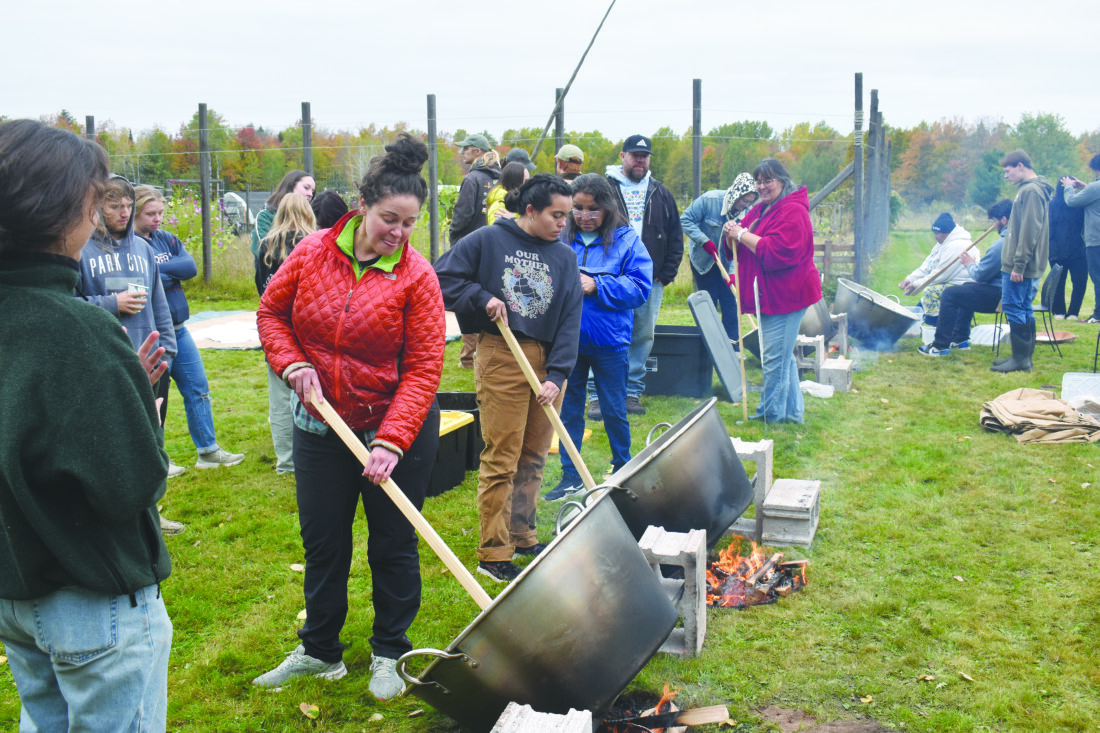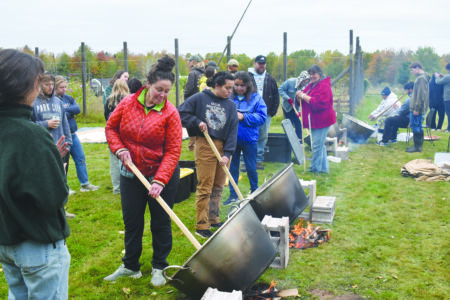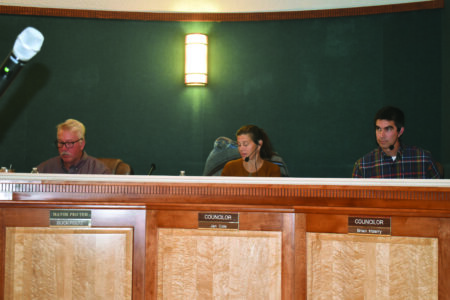Harvest time
KBIC hosts Manoomin Camp

Camp participants try their hand at parching rice during the annual Manoomin Camp in L'Anse. The camp teaches the cultural significance of wild rice along with how to prepare it for an edible state.
L’Anse — The Keweenaw Bay Indian Community (KBIC) Natural Resources Department and the Keweenaw Bay Ojibwa Community College (KBOCC) held the annual Manoomin (wild rice) Camp Saturday to introduce traditional and modern process of ricing and educate participants of the crop’s cultural significance. Around 100 participants, both new and returning participants, prepared rice into an edible state.
The camp was open to both KBIC and non-tribal members who were interested in the camp. Attendees first listened to stories revolving around ricing, including tales which explained how the Anishinaabe people sought wild rice as sustenance. KBOCC Board of Regents member and Great Lakes Indian Fish and Wildlife Commission employee Kathleen Smith said the building of relationships within the community is the most important aspect of the camp.
“So we’re using manoomin as a healing medicine, because we have a lot of trauma on all walks of life, so we bring everybody together, centered around manoomin,” she explained. “It’s healing by bringing us all together, and learning from one another. Everyone who has knowledge of how their ancestors gathered foods and hunted foods shares this knowledge. We’re doing a knowledge exchange, kind of a cultural exchange too, because it’s not only us Ojibwa that have this knowledge but there could be a lot of non tribal people that have knowledge as well. Manoomin is being that spirit to really bring us together and learn from rice.”
Smith oversaw participants parching the rice in basins in the beginning stages of preparing rice, and gave instructions as she explained what the processes entailed. She also discussed some of the progress being made bringing rice back as a larger recognized crop in Michigan.
“We’re actually having restoration projects going on in our own community here around Keweenaw Bay,” Smith said. “It’s actually on public lands where everybody can go out and harvest, especially tribal members. That’s one of the things that we kind of look for in our community — can our tribal members go and harvest manoomin? We always make sure it’s in the public area that’s accessible by anybody. So then that way we always have that food and medicine.”
KBIC Natural Resources Department Wildlife and Habitat Manager Erin Johnston said in Michigan there are no real protections or regulations around wild rice, but tribes and partners are working to restore wild rice back to the landscape. Johnston thinks there may not be full awareness of rice’s important significance not just culturally, but ecologically.
“It’s just an important native plant to have,” Johnston said. “The waterfowl enjoy it and muskrats enjoy it, it’s just ecologically a really important species.”
Smith added movements are also growing in northern Wisconsin to bring back rice beds to areas which they historically grew. As the efforts to bring back wild rice grows, so does the outreach, reunions and cultural exchange it creates at events such as the camp.
“I love seeing our partners from other agencies here. I love seeing the kids here. I just love that it’s a very safe and fun space to just ask questions that you may have,” Johnston said. “You just get in there and [it’s] hands on learning. I think that’s the best kind of learning.”
While learning and community are large factors in the rice camp, Smith said her favorite part of the camp is eating the rice in the end.
“Just to be able to taste manoomin, that’s my favorite part because we go through this year long process of monitoring these lakes, constructing the tools around rice. And then in Fall time we’re harvesting waawaashkeshi, which is the deer, because we use the hides to make moccasins, and also feed off the meat for our feasts. So we always feast on manoomin too,” Smith said.
Smith also shared her favorite dishes made with manoomin, which included soups, meatloafs and salads. She, however, went into some detail about a particular manoomin dish.
“I also put Greek yogurt in my manoomin with maple syrup that I also make myself in the springtime. That’s the first medicine that wakes up so we always honor that and throw in some blueberries or any kind of berries or fruit. So that’s my favorite way of waking up in the morning.”



